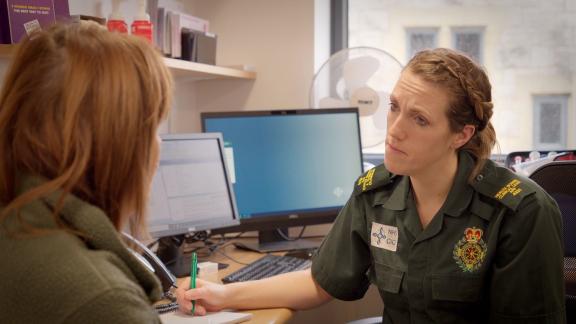How advanced paramedics are easing pressures on A&E

Hannah Lowther welcomes the next patient into her office. After some questions about the nature of the patient’s symptoms and a check on her medical history, Hannah continues with a physical examination – all routine fare for a GP settling in for a day’s work at their local practice. Except for one thing – Hannah isn’t a GP.
She’s a paramedic.
Hannah works at the surgery at the West End Medical Centre in Colwyn Bay, in North Wales once a week, throughout the year. It’s part of her role as an advanced paramedic practitioner, or APP.
“I’ve always loved learning”, explains Hannah, “and even when I originally qualified as a paramedic, I knew there was going to be so much more to learn in medicine.” It was a career choice she began mulling over during the long waits outside A&E, waiting for patients to be offloaded.
And in a twist of irony, reducing A&E wait times is one of the key reasons for having APPs in the first place.
The pressure on emergency departments throughout the UK is immense, and any initiative that results in fewer people being sent to A&E can make a sizeable difference. Which is where APPs come in.
Navigating patients through the healthcare system
An APP undertakes a three-year master’s degree in advanced clinical practice, incorporating education, research, clinical and leadership skills, explains Kerry Robertshaw. Kerry is a consultant paramedic for the Welsh Ambulance Services University NHS Trust and the driving force behind the expansion of advanced paramedics across Wales.
“When we train a paramedic to advanced practice level, they have a much better ability to navigate patients through the healthcare system”, Kerry explains.
An advanced paramedic has a broader range of skills and knowledge. “They can take an advanced clinical assessment on location and really understand the exact needs of the patient at that moment in time”, she says.
An APP can use a wider range of medications, such as antibiotics, steroids and pain relief. They may also independently prescribe medications, or even de-prescribe medications with harmful side effects.
“Our population is living longer, with more complex chronic conditions, and increasing frailty”, says Kerry.
By tailoring management plans to the patient, the result is that many fewer patients are sent to A&E. “We’ve seen the conveyancing rate to hospital drop from around 55 – 65 per cent down to 23 – 35 per cent when APPs are involved,” Kerry points out.
Managing patients in the community
It’s all well and good to have APPs ready to go when a call comes in, but making best use of their skills requires knowing which patients to send them to.
Dr Becci Smith is associate medical director for community care within the trust. She also works in a triage call centre monitoring 999 call logs. Being aware of the skill set of APPs allows them to identify the opportunities where they can have a significant impact on patients.
“They've [APPs] grown in experience over the years in what they're comfortable to consult on and manage those patients in a closed loop system”, she says, “so we're not referring so many patients back onto primary care again, or sending them to acute settings. It means a lot more patients can be managed at home, relieving pressure on other areas such as primary and urgent care services.”
According to Becci, having APPs in what they call a ‘rotational model’ is key to the initiative’s success. Advanced paramedics rotate between attending 999 calls, remotely triaging patients, and working out of primary care centres, each for six-week periods. When fully qualified, longer-term arrangements that involve splitting their weekly work schedule between different settings can be agreed.
“As paramedics we’re very good at assessing and taking a history, but we don’t always know how to best manage a patient in the community, whether to send them to ED or manage follow-up services,” says Hannah Lowther.
“As an APP I’m refining that skill set here. I’m also sharing my knowledge of how paramedics work with primary care practitioners, so they know how to use 999 more effectively, or what to do in an emergency. And because both elements of my work are in the same community, I’m more likely to be aware of local patients with complex medical history. When they show up on a 999 call, I understand better how to manage them.”
Hannah identifies another advantage to higher volume of people she tends to see in the GP practice: “you get to see a greater depth and breadth of patients, so you get to use your prescribing and assessment skills much more. Although you’re often doing it in more detail for [the trust], the volume of assessments you carry out, and the corresponding prescriptions, is much greater when you’re in primary care.”
Patients triaged for consultations with APPs through primary care settings include those with complex, multiple and long-term conditions, frail, elderly or care home residents, those requiring a medicines review, children and those with minor illness.
In addition to carrying out face-to-face consultations, they provide extra capacity and expertise to conduct home visits, and where appropriate, remote consultations too. They complement the work of resident GPs and work under their supervision – they do not replace them.
From an initial pilot in 2017, the advanced paramedics rotational model has successfully grown, with all health boards across Wales implementing some form of the strategy and many similar schemes now established across England too.



